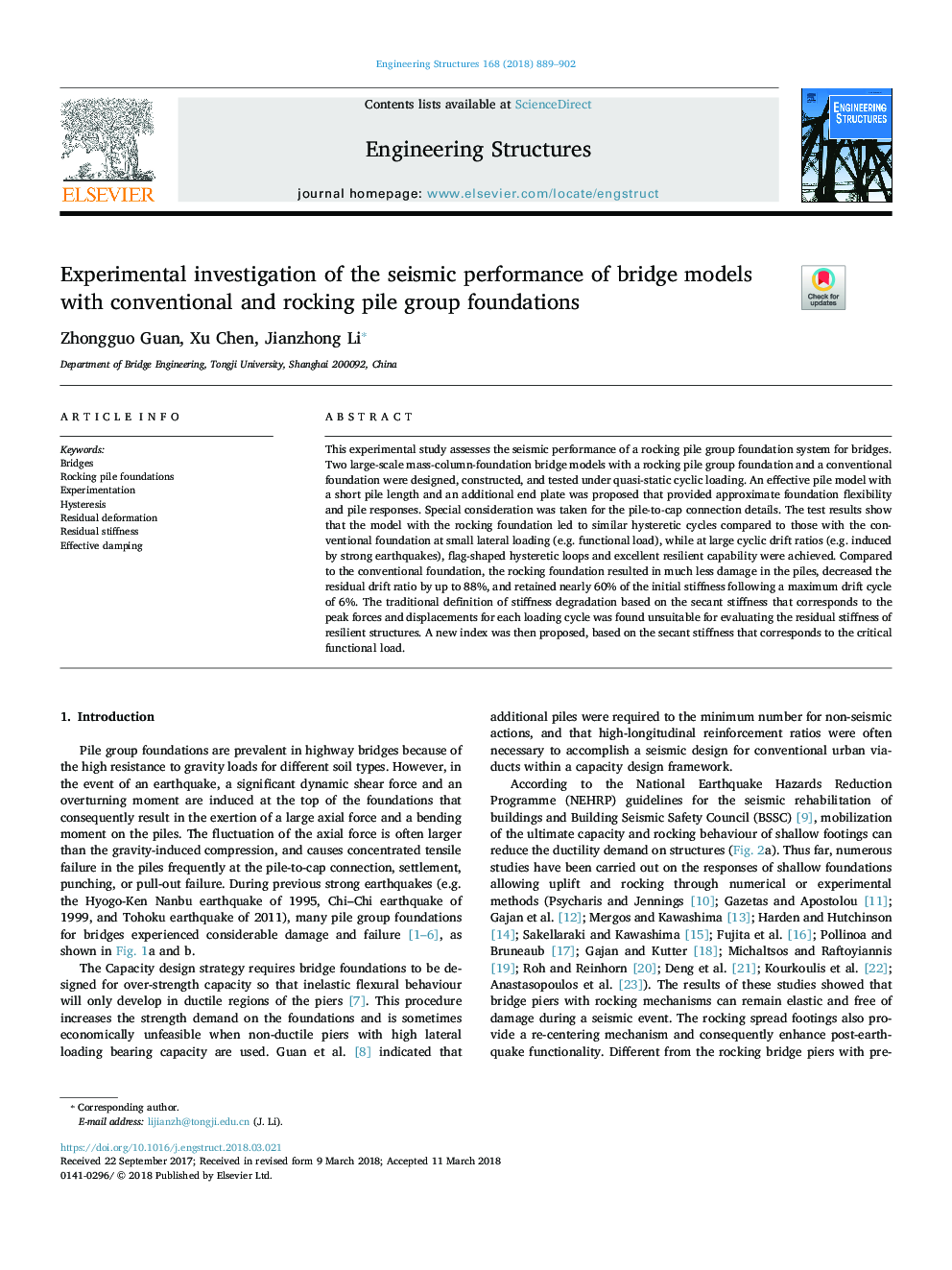| کد مقاله | کد نشریه | سال انتشار | مقاله انگلیسی | نسخه تمام متن |
|---|---|---|---|---|
| 6737381 | 1429059 | 2018 | 14 صفحه PDF | دانلود رایگان |
عنوان انگلیسی مقاله ISI
Experimental investigation of the seismic performance of bridge models with conventional and rocking pile group foundations
ترجمه فارسی عنوان
بررسی تجربی عملکرد لرزه ای مدل های پل با بنیادهای گروه های شمع متعارف و شیب دار
دانلود مقاله + سفارش ترجمه
دانلود مقاله ISI انگلیسی
رایگان برای ایرانیان
کلمات کلیدی
پل ها، پایه شمع سنگفرش آزمایش هیسترزیس، تغییر شکل باقی مانده، سختی باقی مانده، ماندگاری موثر،
ترجمه چکیده
این مطالعه تجربی، عملکرد لرزه ای یک سیستم پایه گروه شمع را برای پل ها ارزیابی می کند. دو مدل پل بزرگ بنیادی با مقیاس بزرگ با پایه گروه شمع شیب دار و بنیاد متعارف طراحی، ساخت و تحت بارگذاری چرخه شبه استاتیک مورد آزمایش قرار گرفتند. یک مدل شبیه ساز مؤثر با طول طول شمع و یک صفحه اضافی که پیشنهاد شده بود، فراهم نمودن انعطاف پذیری پایه و پاسخ های شمع بود. توجه ویژه ای به جزئیات مربوط به اتصال به شمع به شمار می رود. نتایج آزمون نشان می دهد که مدل با پایه شیب دار منجر به چرخه های هیستریتیک مشابه نسبت به آنهایی که دارای بنیاد متعارف در بارگذاری کوچک جانبی (مثلا بار عملکردی) بوده اند، در حالی که در نسبت های راندگی چرخه ای (مانند ناشی از زلزله های شدید)، پرچم شکل حلقه های هیسترتیک و قابلیت انعطاف پذیری عالی به دست آمد. در مقایسه با بنیاد متعارف، بنیاد صخره باعث خسارت بسیار زیادی در شمع ها شد، نسبت رطوبت باقی مانده را تا 88 درصد کاهش داد و تقریبا 60 درصد از سختی اولیه را پس از چرخه حداکثر راندگی 6 درصد حفظ کرد. تعریف سنتی تضعیف سختی بر اساس سختی سفتی که مربوط به نیروهای پیک و جابجایی برای هر بار چرخشی است، برای ارزیابی سختی باقی مانده از سازه های انعطاف پذیر مناسب نیست. پس از آن یک شاخص جدید بر اساس سفتی مخفی که با بار عملکردی مهم مطابقت دارد پیشنهاد می شود.
موضوعات مرتبط
مهندسی و علوم پایه
علوم زمین و سیارات
مهندسی ژئوتکنیک و زمین شناسی مهندسی
چکیده انگلیسی
This experimental study assesses the seismic performance of a rocking pile group foundation system for bridges. Two large-scale mass-column-foundation bridge models with a rocking pile group foundation and a conventional foundation were designed, constructed, and tested under quasi-static cyclic loading. An effective pile model with a short pile length and an additional end plate was proposed that provided approximate foundation flexibility and pile responses. Special consideration was taken for the pile-to-cap connection details. The test results show that the model with the rocking foundation led to similar hysteretic cycles compared to those with the conventional foundation at small lateral loading (e.g. functional load), while at large cyclic drift ratios (e.g. induced by strong earthquakes), flag-shaped hysteretic loops and excellent resilient capability were achieved. Compared to the conventional foundation, the rocking foundation resulted in much less damage in the piles, decreased the residual drift ratio by up to 88%, and retained nearly 60% of the initial stiffness following a maximum drift cycle of 6%. The traditional definition of stiffness degradation based on the secant stiffness that corresponds to the peak forces and displacements for each loading cycle was found unsuitable for evaluating the residual stiffness of resilient structures. A new index was then proposed, based on the secant stiffness that corresponds to the critical functional load.
ناشر
Database: Elsevier - ScienceDirect (ساینس دایرکت)
Journal: Engineering Structures - Volume 168, 1 August 2018, Pages 889-902
Journal: Engineering Structures - Volume 168, 1 August 2018, Pages 889-902
نویسندگان
Zhongguo Guan, Xu Chen, Jianzhong Li,
